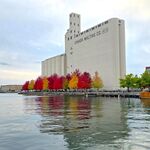Hume
Link to article
Librarians at the gate
Cities worldwide are investing in libraries as never before, hoping for that `Bilbao effect,' the kind of civic shot in the arm only an ambitious building can provide. In its modest way, Toronto is no exception
Nov 03, 2007 04:30 AM
Christopher Hume
Urban Affairs Columnist
Though long overdue, libraries are finally starting to get the respect they deserve. Despite reports of their demise, they have not only survived the onslaught of civic poverty and computerized knowledge, they have thrived.
Cities around the world are investing in libraries as never before. In some instances, new libraries have created their own "Bilbao effect," changing the very image and perception of a community. The most celebrated example is that of Seattle, which famously hired Dutch architect Rem Koolhaas to design its new main branch. The result is one of the most original buildings of the 21st century. Most remarkable, it isn't just another pretty face; it actually functions.
Even more interesting in some respects was the 2002 "reconstruction" of the legendary Alexandria Library in Egypt. Destroyed in antiquity, it has been now been dramatically replaced by the Norwegian architectural firm, Snohetta.
Though Toronto has nothing of equal significance, we are well into a library rebuilding campaign that for all its modesty has had impressive results. Most of the work has occurred in small neighbourhood branches such as Runnymede, Malvern and the Beach. A total of 12 buildings have been renovated so far; next year another six will be completed.
Now, the biggest city library of all, the Toronto Reference Library on Yonge St. just north of Bloor, is undergoing renovation. The fact that the building opened 30 years ago this week brings extra meaning to the project, which couldn't have come at a better time.
The truth is that the glass-and-brick heap does not rank among the great libraries of the world, or even the city for that matter. Designed by Toronto architect Raymond Moriyama, it dates from a period when architecture was at a low ebb.
Though Moriyama would go on to produce a number of genuine masterpieces, most notably the Canadian War Museum in Ottawa, the library is one of those buildings in which scale and materials don't quite match. The truth is that Moriyama had to deal with endless political interference, as well as height restrictions that kept the library from being all it could.
"We need $30 million to bring the reference library into the 21st century," says Toronto's head librarian, Josephine Bryant.
"We've done quite a bit already but the master plan calls for significant changes on every floor as well as a new entrance. There will also be an event space on the east side of the building."
The fact the renovations have been designed by Moriyama's son, Ajon, will presumably ensure a degree of continuity. Done properly, they will be welcomed by users. In recent years, the building has started to look shabby, and despite the soaring spaces of the atrium, the library has never brought much interest to this important stretch of Yonge St. If anything, it sucks more life from the city than it gives back.
It will be interesting to see how Bryant's fund-raising campaign fares; after all, the city has just gone through its so-called Cultural Renaissance, to which the philanthropic community donated something like $1.5 billion.
But does our attitude toward libraries allow us to view them as cultural facilities?
In Toronto it seems we understand them as being somewhere between a public work and an educational institution.
They are both, of course, but more. In its essence, the library is a repository of knowledge, as well as an archive and place of learning. Nothing could be nobler, but we prefer they remain in the public sector, paid for with tax dollars.
What's lacking, of course, is the entertainment factor. Opera houses, art galleries and museums are ultimately pleasure palaces; libraries must be more earnest and sincere. They may be good for us, but they're not fun.
Yet even this has started to change, back in 1995 when the Lillian Smith Branch opened on College St., it ushered in a new era of library architecture in Toronto. Designed by architect Phillip Carter, one of the city's great unsung heroes, here is a building so brimming with charm, invention and wit, resistance is futile. With its various styles and decorated forms, it takes enormous delight in its own existence.
So far, no other contemporary library has come close to Carter's exuberance.
How ironic, then, that it dates from the darkest days of the Great Recession.
In that respect little has changed; Toronto libraries seem to exist in a permanent state of recession. When City Council casts around for costs to cut, libraries are always prime targets.
Last month, for example, councillors thought they would close the reference library on Sundays to save a few dollars. Fortunately, they were thwarted. Despite their barbarian efforts, the Toronto Public Library system remains the best used in the world.
"Whenever the city goes through a major upheaval, we get caught," says Bryant. "But we have a very strong board."
Add to that the fact Toronto's libraries have written the book on making a little go a long way. Imagine what they could do adequately funded.




